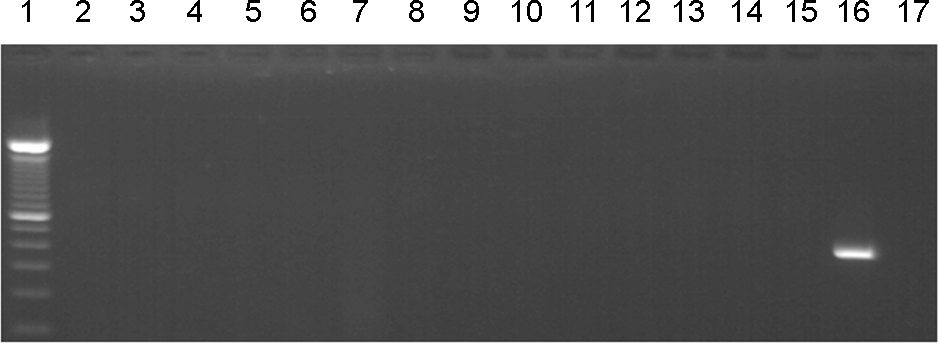Abstract
Severe fever with thrombocytopenia syndrome (SFTS) is firstly reported in China in 2011. Thereafter it is reported an infectious disease in Japan and Korea. It is caused by bunyavirus, called SFTS virus (SFTSV). The main vector of SFTS is Haemaphysalis longicornis tick. We investigated the distribution and detection of SFTSV in ticks collected from the environment using the dragging method and dry ice fogging method from May to November 2014 in Jeollanam-do, Korea. Sampling was taken from the province Suncheon, Gokseong, Boseong, Goheung where patients have occurred in 2013 and Gurye as control. Among the total 3,048 ticks collected, 3,030 ticks were H. longicornis (99.4%) and 18 were Amblyomma testudinarium. H. longicornis was collected 1,330 ticks in Gokseong, 1,188 ticks in Boseong, 240 ticks in Suncheon, 150 ticks in Goheung and 140 ticks in Gurye. Developmental stages by month of H. longicornis were revealed that nymph (92%) was collected from May to June, adult (30%) and nymph (70%) in July, and 93% of larvae from September to October. These results showed the different dominant stage of ticks according to seasons. However, no SFTSV-specific gene was detected in 3,030 ticks of H. longicornis.
REFERENCES
2). Ding F, Zhang W, Wang L, Hu W, Soares Magalhaes RJ, Sun H, et al. Epidemiologic features of severe fever with thrombocytopenia syndrome in China, 2011–2012. Clin Infect Dis. 2013; 56:1682–3.

3). Takahashi T, Maeda K, Suzuki T, Ishido A, Shigeoka T, Tominaga T, et al. The first identification and retrospective study of severe fever with thrombocytopenia syndrome in Japan. J Infect Dis. 2014; 209:816–27.

4). Korean Center for Disease Control and Prevention. Severe Fever with Thrombocytopenia Syndrome in Korean (Internet). Osong: Korean Center for Disease Control and Prevention;Available From:. http://www.cdc.go.kr/CDC/info/CdcKrInfo0302.jsp?menuIds=HOME001-MNU1132-MNU1138-MNU0038&fid=32&q_type=&q_value=&cid=27068&pageNum=.
5). Kim HC, Han SH, Chong ST, Klein TA, Choi CY, Nam HY. Ticks collected from selected mammalian hosts surveyed in the Republic of korea during 2008–2009. Korean J Parasitol. 2011; 49:331–5.

6). Kim KH, Yi J, Kim G, Choi SJ, Jun KI, Kim NH, et al. Severe fever with thrombocytopenia syndrome, South Korea, 2012. Emerg Infect Dis. 2013; 19:1892–4.

7). Yamaguti N, Tipton VJ, Keegan HL, Toshioka S. Ticks of Japan, Korea, and the Ryukyu Islands. Brigham Young Univ Sci Bull Biol Ser. 1971; 15:1–226.
8). Soulsby EJL. Helminths, arthropods, & protozoa of domesticated animals. 7th Edition. Williams and Wilkins Co.;Baltimore: 1982. p. 456–67.
9). Kim CM, Yi YH, Yu DH, Lee MJ, Cho MR, Desai AR, et al. Tick-borne rickettsial pathogens in ticks and small mammals in Korea. Appl Environ Microbiol. 2006; 72:5766–76.

10). Shin SH, Seo HJ, Choi YJ, Choi MK, Kim HC, Klein TA, et al. Detection of Rickettsia monacensis from Ixodes nipponensis collected from rodents in Gyeonggi and Gangwon Provinces, Republic of Korea. Exp Appl Acarol. 2013; 61:337–47.
11). Lee JH, Ahn SJ, Park HS, Jeong EJ, Choi HG, Jang WJ, et al. Prevalence of Spotted Fever Group Rickettsia from Haemaphysalis Ticks in Chungju Provice. J Bacteriol Virol. 2005; 35:203–7.
12). Kim HC, Han SH, Chong ST, Klein TA, Choi CY, Nam HY, et al. Ticks Collected from Selected Mammalian Hosts Surveyed in the Republic of Korea During 2008–2009. Korean J Parasitol. 2011; 49:331–5.

13). Lim CS, Lee WK. Acari Attracted to Carrion of Chicken and Cattle, Korean J Sail Zool. 2005; 10:16–21.
14). Park SW, Song BG, Shin EH, Yun SM, Han MG, Park MY, et al. Prevalence of severe fever with thrombocytopenia syndrome virus in Haemaphysalis longicornis ticks in South Korea. Ticks Tick Borne Dis. 2014; 5:975–7.
15). Kim BJ, Kim H, Won S, Kim HC, Chong ST, Klein TA, et al. Ticks Collected from Wild and Domestic Animals and Natural Habitats in the Republic of Korea. Korean J Parasitol. 2014; 52:281–5.

Figure 1.
The results of amplification of SFTSV RNAs by RTPCR from the pooling ticks collected from Jellanam-do, 2014. Lane 1 show molecular weight marker, lane 2~15: PCR products from the pooling ticks, lane 16: positive control (410 bp), lane 17: negative control.

Table 1.
The number of ticks collected from the five regions of Jellanam-do, 2014
| Regions | Haemaphysalis longicornis | Amblyomma testudinarium | Total |
|---|---|---|---|
| Suncheon | 240 | 0 | 240 |
| Gokseong | 1,320 | 10 | 1,330 |
| Gurye | 140 | 0 | 140 |
| Goheung | 150 | 0 | 150 |
| Boseong | 1,180 | 8 | 1,188 |
| Total | 3,030 | 18 | 3,048 |
Table 2.
Developmental stages of Haemaphysalis longicornis collected from the five regions of Jellanam-do, 2014
| Regions | Ticks number | Larvae | Nymph | Adult |
|---|---|---|---|---|
| Suncheon | 240 | 50 | 150 | 40 |
| Gokseong | 1,320 | 1,000 | 280 | 40 |
| Gurye | 140 | 0 | 120 | 20 |
| Goheung | 150 | 100 | 20 | 30 |
| Boseong | 1,180 | 700 | 450 | 30 |
| Total | 3,030 | 1,850 | 1,020 | 160 |
Table 3.
Monthly distributional studies of Haemaphysalis longicornis based on the developmental stages from the five regions of Jellanam-do, 2014




 PDF
PDF ePub
ePub Citation
Citation Print
Print


 XML Download
XML Download